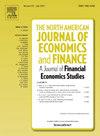Understanding the connectedness between US traditional assets and green cryptocurrencies during crises
IF 3.9
3区 经济学
Q1 BUSINESS, FINANCE
North American Journal of Economics and Finance
Pub Date : 2025-07-16
DOI:10.1016/j.najef.2025.102474
引用次数: 0
Abstract
This research examines the dynamic interaction between conventional financial assets, namely the US dollar, the S&P 500 index, gold and crude oil, and ten major green cryptocurrencies, focusing on their spillover linkages and hedging capacities during major global economic and geopolitical shocks. The study analyses daily data to uncover spillover effects using the innovative Quantile-Vector Autoregressive methodology developed by Cunado et al. (2023). Results indicate that green cryptocurrencies significantly interact with other examined instruments. Algorand, Cardano, IOTA, TRON and Powerledger demonstrate the largest interactive effects, with the latter standing out as a consistent transmitter of influence across both crises, demonstrating that this sub-class of cryptocurrency is exhibiting elevated maturity. Traditional assets predominantly act as receivers of such risk dynamics from more speculative asset classes, with gold identified as an effective absorber of spillovers, especially in bear markets. Conversely, the US dollar and crude oil are identified as large transmitters of spillover impacts, a result found to be particularly influential in periods of geopolitical conflict. The study further reveals that green cryptocurrencies promoting trust, innovation, and renewable energy are more effectively connected with traditional investments than those focusing on financial services or business accessibility, presenting diversification opportunities during crises.
了解危机期间美国传统资产与绿色加密货币之间的联系
本研究考察了传统金融资产(即美元、标准普尔500指数、黄金和原油)与十大绿色加密货币之间的动态相互作用,重点研究了它们在重大全球经济和地缘政治冲击期间的溢出联系和对冲能力。该研究使用Cunado等人(2023)开发的创新分位数向量自回归方法分析日常数据,以揭示溢出效应。结果表明,绿色加密货币与其他被检查的工具显着相互作用。Algorand、Cardano、IOTA、TRON和Powerledger表现出最大的互动效应,后者在两次危机中都表现出一致的影响力,表明这一子类的加密货币正表现出更高的成熟度。传统资产主要充当来自更具投机性的资产类别的风险动态的接受者,而黄金被认为是溢出效应的有效吸收器,尤其是在熊市中。相反,美元和原油被认为是外溢影响的大传播者,这一结果在地缘政治冲突时期尤为重要。该研究进一步表明,促进信任、创新和可再生能源的绿色加密货币比那些专注于金融服务或商业可及性的加密货币更有效地与传统投资联系在一起,在危机期间提供了多样化的机会。
本文章由计算机程序翻译,如有差异,请以英文原文为准。
求助全文
约1分钟内获得全文
求助全文
来源期刊
CiteScore
7.30
自引率
8.30%
发文量
168
期刊介绍:
The focus of the North-American Journal of Economics and Finance is on the economics of integration of goods, services, financial markets, at both regional and global levels with the role of economic policy in that process playing an important role. Both theoretical and empirical papers are welcome. Empirical and policy-related papers that rely on data and the experiences of countries outside North America are also welcome. Papers should offer concrete lessons about the ongoing process of globalization, or policy implications about how governments, domestic or international institutions, can improve the coordination of their activities. Empirical analysis should be capable of replication. Authors of accepted papers will be encouraged to supply data and computer programs.

 求助内容:
求助内容: 应助结果提醒方式:
应助结果提醒方式:


